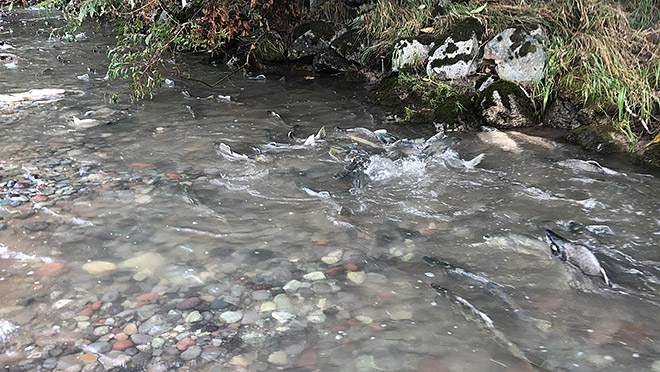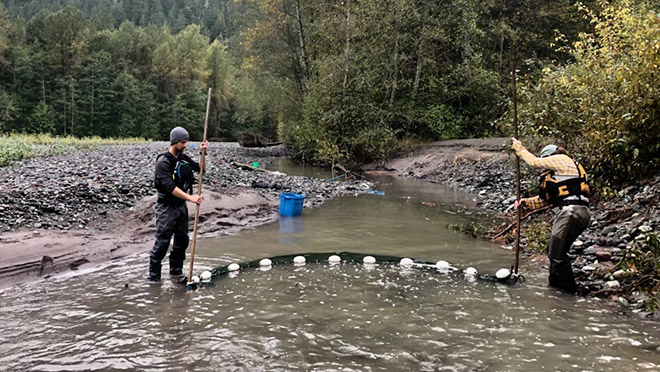In a summer of low water, the pink salmon are coming

Increased monitoring efforts on the Cheakamus River to protect spawning fish
When the pink salmon start running, anglers rejoice and our crew monitoring the Cheakamus River near Squamish gets busy. It's a once-every-two-years cycle, with the pinks migrating from the Pacific Ocean into the Squamish River and then into the Cheakamus to spawn and then die.
It's a time when unpredictable weather, and our control of water levels on the Cheakamus, will be in the spotlight. If there are no big rainstorms during the pink spawning season – roughly mid-August into October – the pinks will likely go about their business of egg-laying without issue. But if big rains hit, some pinks could be stranded after water recedes and shallow, temporary channels dry up.
Either way, millions of eggs will hatch, with the salmon fry moving downstream, first to the estuary at the mouth of the Squamish River, and then out to the open ocean, where they'll grow large and return to spawn in the Cheakamus two years later.
Across B.C., water levels are at dangerously low levels this summer – B.C.'s River Forecast Centre reported in late July that more than 20% of its river monitoring stations were showing water levels at record low levels. And when droughts hit, salmon and other fish can be at risk. BC Hydro has been taking proactive steps at many of our South Coast facilities for months to conserve water to protect the downstream fish habitat.
BC Hydro's reservoirs play an important role in managing these difficult conditions by using storage and planning releases to provide protection to downstream river flows. While the dry conditions have had an impact on BC Hydro’s watersheds, several unregulated natural river systems – not related to BC Hydro – have fared worse in previous years, with rivers drying up and thousands of fish killed. During last fall's drought conditions, tens of thousands of pink and chum salmon died before spawning, starved for oxygen on a water-depleted river near Bella Bella on B.C.'s central coast.
Low water can cause stranding of fish, and so can large or sudden changes in water levels. Two years ago, pinks were stranded in pools on the Cheakamus after water levels dropped following a major storm in early fall.
Both the number of pink salmon returning to the Cheakamus, and the weather during spawning season, are impossible to predict. But the ability to control water levels on the Cheakamus, and inflows to the system from glacier melt, can give the salmon on the river an advantage over those on wild rivers hit by drought. We're getting better at monitoring the salmon, fine-tuning flow reductions known as "rampdowns" on the Cheakamus, and regularly updating the local community, First Nations, and anglers on the river.
"Last year, we hit our freshet peak on the river in June or July, and basically just ramped the flows down slowly, all the way into the fall," says BC Hydro natural resource specialist Sterling Pearce. "It wasn't a pink year, but there was no opportunity for fish to get stranded, because there weren't any big storms or high flow scenarios. If the same thing happened this year, we could go through a whole pink season without having to send crews onto the river, other than for the weekly floats [on rafts] to monitor the salmon."
We know our operations can strand fish. While it's an unfortunate reality that fish stranding can't be entirely prevented, we're actively working with First Nations, regulators, and stakeholders to learn about the system and improve our response every season.
If there's a big storm this August or September, pinks – far more likely than other fish to spawn in outer, shallow pools of water created by a surging river – could be stranded once the water recedes. If that happens, Pearce and his fish crews will be on the river returning as many stranded pinks as possible back to the main, deeper channels of the river.
"In an unregulated [undammed] river system, those pinks would just become food for eagles, bears and raccoons – everybody comes to the feast," says Pearce. "But we know that having our operations on the river does have impacts. And we've committed to having a bigger response to stranding – basically more people to move fish back into the water. We have a lot of people who have gone through swift-water training so that they're safe on the river, and we've built out a substantial list of qualified people we can call for help if there is a large stranding event."
Pearce prefers, however, to focus on the good-news scenario: the prospect of a late summer without storms or stranded salmon, where the emphasis is on the sight of tens of thousands of spawning pink salmon, something he calls "an amazing spectacle".

Daisy Lake Reservoir stores water to power 96,000 homes
For decades, the Cheakamus generating station has been providing British Columbians with enough renewable electricity to power the equivalent of 96,000 homes per year. Located 40-km north of Squamish on the unceded traditional territory of the Squamish Nation, Tseil-Watuth Nation, and Lil'wat Nation, the Daisy Lake Dam impounds water flowing south in the Cheakamus River creating Daisy Lake Reservoir. The water in Daisy Lake Reservoir takes one of two paths to the Squamish River. It's either released from the dam down a 26-km stretch of the Cheakamus River to its confluence with the Squamish River, or it's diverted through a tunnel that runs through Cloudburst Mountain to the Cheakamus Generating Station on the Squamish River.
BC Hydro operates the dam, its discharge facilities, and the generating station in accordance with its water licences and the 2006 Water Use Plan Order, which sets guidelines for balancing power generation, fish flows and flood protection, as well as recreation. Daisy Lake is a relatively small reservoir for the inflows it can see during heavy rainfall events, meaning storm events will result in large fluctuating flows on the Cheakamus River.
"Managing river flows for fish is a real focus for operations all year round, and especially during critical spawning periods," says BC Hydro operations manager Helen Hamilton Harding. "But this reservoir can fill up super quickly. With the big storms, the atmospheric rivers we see on the coast, it can be like a firehose that might get pointed at this river basin, or might be 10-km to the west, missing us entirely. So we have to be ready to respond and make quick decisions."